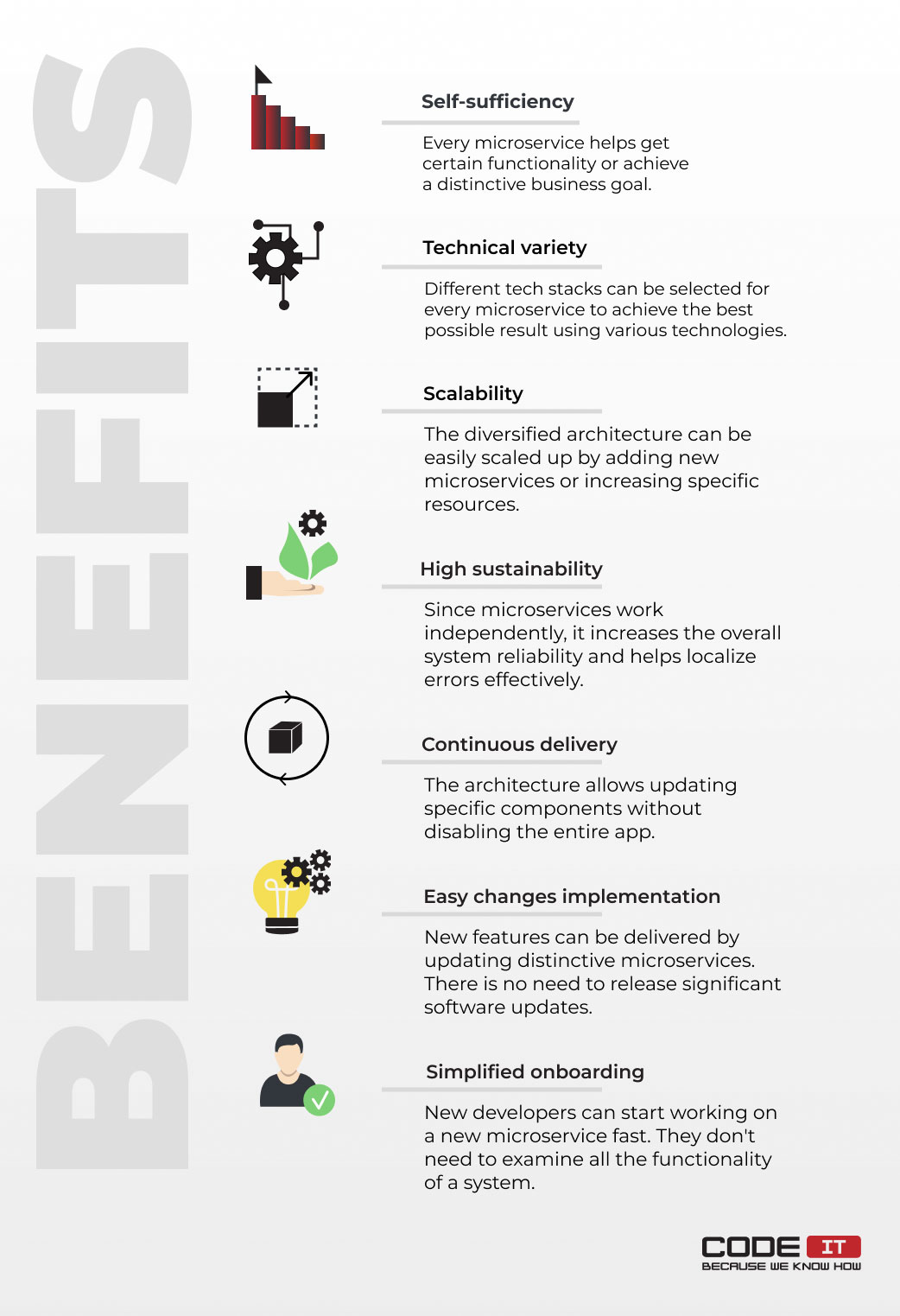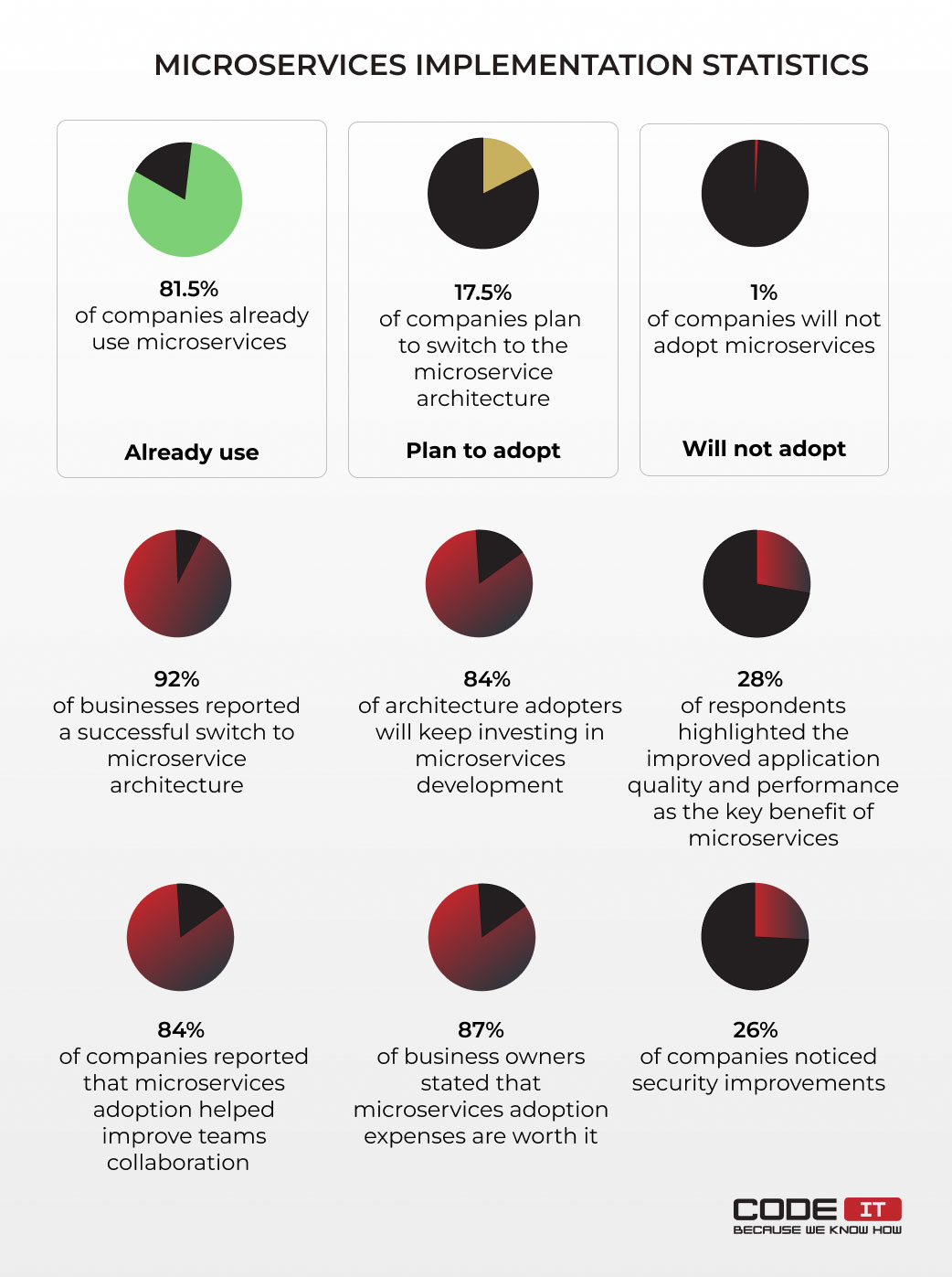Benefits of Microservices Architecture


The use of microservices for building digital products is a new trend in the software development industry. According to recent statistics, roughly 4 out of 5 businesses already use microservices. The many benefits of microservices make this architecture type more popular compared to its ancestor, the monolithic architecture.
In the post, you will explore the reasons why the use of microservices gains popularity. Also, you’ll discover the challenges the microservice architecture helps solve.
What is microservice architecture
Microservices is an architecture type used for building software using many distinctive solutions combined into an app. Each microservice is responsible for tackling a small and specific task. Since an app’s architecture is split into different pieces, it may have various business logic, tech stacks, and databases, ensuring data consistency and data integrity.

Microservices communicate with each other using HTTP/HTTPS requests and third-party APIs. For instance, you can easily compose an application using distinctive accounting, payment gateway, and shipping services connected to one application. API communication ensures smooth interactions and secured data transfer.
Real-world applications may have dozens or hundreds of microservices connected to one system.
Build a microservice app with Codeit

Business First
Code Next
Let’s talk
Key Characteristics of Microservice Apps
Indeed, due to the distributed architecture, microservices applications have distinctive peculiarities. The key characteristics of a microservice app are:
1. Independent components
One of the primary benefits of the microservice architecture over the monolith is the use of independent services. They are responsible for completing certain tasks only. Distinctive microservices don’t affect other components of an application. Service isolation ensures that failures remain contained.
2. Decentralized approach
Each microservice has its database and data processing unit. Therefore, there is no need to maintain an expensive centralized database and server to process and store all the information. Moreover, the decentralized product development approach offers the opportunity to apply various technologies to achieve certain business goals, ensuring compliance standards like GDPR and HIPAA.
3. Great evolutionary
The benefits of the microservice architecture foresee the opportunity to upgrade applications by adding new features fast. Consequently, applications that use microservices can quickly grow and obtain new functionalities with automation and DevOps culture.
4. Failure resistance
Since each microservice is an independent part, it can be isolated or disabled. In such a case, the entire application may lack certain functionality. However, fault-tolerant microservices will keep working without any issues, preventing cascading failures. The updated microservice can be connected back after fixing an error, ensuring resilience of infrastructure.
Benefits of microservice architecture
The benefits of the microservice architecture help businesses develop reliable, scalable, and easy-to-maintain applications fast. Let’s explore the advantages of the microservice architecture in more detail below.

1. Self-Sufficiency
Every microservice is an independent node used to build an app. The decentralized approach helps develop self-sufficient applications that can work effectively by combining different technologies. Each microservice is designed to help achieve certain business goals.
Therefore, developers can easily upgrade and update components without affecting the overall software. When a new challenge appears, a business can easily develop and add a new microservice or upgrade the existing one to solve a new problem, aided by container orchestration tools and event-streaming technologies.
For instance, an online store owner can connect the following third-party tools using API integrations or HTTP/HTTPS requests:
- an accounting system
- a payment gateway
- an inventory management system
- a customer portal
- a web analytics service
All the services can work independently and be maintained separately, which is one of the main benefits of microservices.
Monolithic Architecture vs Microservices
2. Technical Variety
Applications that are built using the monolithic architecture use the defined tech stack. Developers have to use the selected set of technologies and adjust them to build new solutions.
Oppositely, microservices offer the opportunity to use various technologies to achieve business goals. It brings outstanding flexibility in the use of technologies.
Every microservice can be developed using a set of different technologies and programming languages to get the best solutions possible. Businesses can choose technologies to use based on their access to tech talents or problems needed to solve. The can pick the best-matching AWS developer tools, CI/CD servers, and continuous integration pipelines for each microservice to achieve the best performance and user experience.
Here are the most popular programming languages and their best uses:
- Java — web and mobile applications, embedded systems
- Python — machine learning and artificial intelligence
- C++ — local applications, proprietary services
- PHP — server-side web development and command-line scripting
- SQL — data analysis and big data mining
- Ruby — back-end web and data processing
Any programming language can be used to develop microservices to take the most advantage of every technology.
Gather a team of developers with required skills

Business First
Code Next
Let’s talk
3. Scalability
The ability to scale up an application fast is one of the most important features of the microservices architecture. Most businesses value the outstanding flexibility offered by microservices. Since each microservice uses a distinctive technology and database, it can be scaled up independently. Rate-limiting ensures that spikes in demand don’t compromise performance and reliability of the entire application.
Therefore, you can start small by using the minimum required amount of resources for every microservice to keep your operating costs as low as possible. When the load on one microservice increases, its database and computing power can be expanded separately.
Moreover, the dispersed architecture foresees the ability to upgrade your software by adding new microservices. For instance, if a business needs an alternative payment gateway, it can be easily connected and added to the checkout.
In case additional functionality is needed to achieve business goals, software engineers can develop it to expand the number of services offered by a company. There is no limit to the number of microservices that can be connected. For example, Netflix’s web application is divided into more than 700 microservices.
4. High Sustainability
The use of microservices helps build highly sustainable applications. Microservices are loosely connected, so they work as independent parts.
Therefore, if a microservice stops working because of technical issues, the app’s functionality is poorly affected. Moreover, other microservices will likely not be affected by a node’s outgate. The ability to allocate and fix errors is one of the top benefits of microservices.
For instance, if a payment gateway installed stops working, users can explore the site, add goods to the cart, and even make purchases online if an alternative payment solution is available.
5. Continuous Delivery
Continuous delivery is a part of CI/CD, a method that helps automate product development and release processes to increase the overall performance of teams.
Since microservices work autonomously, developers can easily establish a continuous integration/continuous delivery environment. They can upgrade certain services without disabling the entire application. Software engineers can release new features effectively, keeping the maximum uptime of an application.
6. Minor Changes are Easier To Implement
The decentralized architecture of microservice applications helps developers implement minor updates seamlessly. Software engineers can temporarily disable a microservice to implement minor changes, making a small piece of functionality unavailable for used users. The app will remain unaffected because there is no need to redeploy the entire system to update some features when using the microservice architecture.
7. Simplified Onboarding
Since the entire app is divided into small microservices that have distinctive tech stacks, the onboarding process is fast. New software engineers don’t need to explore the source code of a huge monolithic application.
Vice versa, they have to inspect a small microservice to start working on a new project. Microservices help draw new developers and onboard them faster, optimizing the overall product development time.
Problems microservice architecture helps solve
The microservice architecture helps solve a lot of problems for large businesses and enterprises that grow fast. Top tech companies have already switched to microservices because they help solve the following problems:
Complex Codebase
Monolithic applications that constantly evolve by adding new features have complicated codebases. The use of microservices helps software engineers to reduce the complexity of an application’s codebase.
Poor Scalability
The majority of large businesses and enterprises have switched to microservices because this architecture type foresees the opportunity to scale up an app fast and stress-free. Moreover, businesses can develop and connect new features to evolve their applications, ensuring service level security measures are maintained.
Unacceptable Downtime
Outstanding failure resistance and the absence of the need to redeploy an application to release new apps are the key benefits of using the microservice architecture. They help significantly increase an app’s uptime to cut business losses, supporting autonomous operation.
Deficient Technology Stack Capabilities
Some technologies may not offer the required tools to solve business problems. The use of microservices helps overcome this challenge because software engineers can create microservices using various technologies and connect them.
Develop a microservice application hassle-free

Business First
Code Next
Let’s talk
Microservices implementation statistics
What are the benefits of microservices architecture in the real world? Feel free to find it out by exploring the microservices implementation statistics in more detail.

According to the research conducted by Statista, 81.5% of companies already use microservices, and 17.5% of businesses plan to switch to this architecture type. However, only 1% of respondents were satisfied with monolithic architecture.
Let’s take a closer look at the microservices implementation statistics prepared by IBM below.
- 92% of businesses experienced zero issues when switching to the microservices architecture
- 84% of respondents stated that they will keep investing in microservices development
- 28% of companies stated that improved application quality and performance are the key benefits of microservices
- 84% of businesses noticed improved collaboration between team members
- 87% of companies stated that the microservices adoption expenses are worth it
- 26% of microservices adopters noticed security improvements
Conclusion
The microservice architecture is the best choice for large companies and enterprises that have to maintain the fast growth of their businesses. The core benefits of microservices are:
- self-sufficiency
- technical variety
- scalability
- high sustainability
- continuous delivery
- minor changes are easier to implement
- simplified onboarding
Due to the many advantages of microservices, roughly 81.5% of companies already use this architecture type. 17.5% of businesses plan to adopt the microservices architecture in the future.
Want to develop a microservice app but lack expertise?

Business First
Code Next
Let’s talk
FAQ
Microservices help develop dispersed architectures of applications. The main principle of the microservice architecture is using various services connected to an app using HTTP/HTTPS requests or API integrations.
The main advantages of microservices over the monolithic architecture are:
- self-sufficiency
- technical variety
- scalability
- high sustainability
- continuous delivery
- minor changes are easier to implement
- simplified onboarding
Microservices applications have distinctive peculiarities that stand them out from the crowd. The main four features are:
- independent components
- decentralized approach
- great evolutionary
- failures resistance
The main goal of using microservices is to break a monolithic app into distinctive parts. Each service can be built using various technologies, updated, and scaled independently. The decentralized approach helps develop failure-proof applications.
The main microservices challenges are:
- More complicated development — Software engineers have expertise in using various technologies and establishing connections between microservices
- Greater resource consumption — The development of the microservices architecture needs to involve a lot of various teams of software engineers
- Complicated development — In the case of using a large number of microservices, developers have to establish a lot of connections between an app’s parts
- Complicated testing — A system that consists of disparate parts built using various technologies needs to be tested thoroughly by QA engineers
Build your ideal
software today







